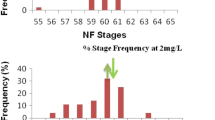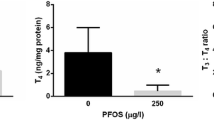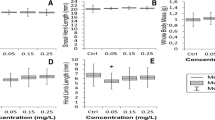Abstract
Perfluorooctane sulfonate (PFOS), one of the emerging persistent organic pollutants (POPs), has caused growing international concern especially related to the potential disruption in the development and function of thyroid system. Xenopus laevis is an amphibian species widely used as a suitable amphibian model for thyroid disruption research. To study the thyroid disruption effects related to PFOS exposure at environmental low levels, X. laevis tadpoles were exposed to 0.1, 1, 10 and 100 μg/l PFOS in water respectively from stage 46/47 to stage 62. The results showed that the time to metamorphosis (presented by forelimb emergence, FLE) did not significantly change with PFOS exposure, but exhibited an increasing trend (except for 10 μg/l exposure). Partial colloid depletion was observed for PFOS exposure, but no significant histological abnormality was observed in treatment groups. In addition, PFOS exposure resulted in up-regulation of thyroid hormone-regulated genes—thyroid receptor beta A (TRβA), basic transcription element-binding protein (BTEB) and type II deiodinase (DI2) mRNA expression, presented as an inverted U-shaped dose response pattern. However, the mRNA expression of type III deiodinase (DI3) remained unaffected compared with the control. These results demonstrated that PFOS might disrupt the thyroid system in X. laevis tadpoles regarding FLE changes and regulation alternation of thyroid hormone-regulated genes. Our study has raised new concerns for possible thyroid disruption of PFOS in amphibians at environmental relevant levels.






Similar content being viewed by others
References
Ankley GT, Kuehl DW, Kahl MD, Jensen KM, Butterworth BC, Nichols JW (2004) Partial life-cycle toxicity and bioconcentration modeling of perfluorooctanesulfonate in the northern leopard frog (Rana pipiens). Environ Toxicol Chem 23(11):2745–2755
Ankley GT, Kuehl DW, Kahl MD, Jensen KM, Linnum A, Leino RL, Villeneuvet DA (2005) Reproductive and developmental toxicity and bioconcentration of perfluorooctanesulfonate in a partial life-cycle test with the fathead minnow (Pimephales promelas). Environ Toxicol Chem 24(9):2316–2324
Beach SA, Newsted JL, Coady K, Giesy JP (2006) Ecotoxicological evaluation of perfluorooctanesulfonate (PFOS). Rev Environ Contam Toxicol 186:133–174
Cai L, Brown DD (2004) Expression of type II iodothyronine deiodinase marks the time that a tissue responds to thyroid hormone-induced metamorphosis in Xenopus laevis. Dev Biol 266(1):87–95
Calabrese EJ (2004) Hormesis—basic, generalizable, central to toxicology and a method to improve the risk-assessment process. Int J Occup Environ Health 10(4):466–467
Calabrese EJ (2005) Toxicological awakenings: the rebirth of hormesis as a central pillar of toxicology. Toxicol Appl Pharmacol 204(1):1–8
Calabrese EJ, Baldwin LA (1999) Chemical hormesis: its historical foundations as a biological hypothesis. Toxicol Pathol 27(2):195–216
Calabrese EJ, Baldwin LA (2001a) U-shaped dose-responses in biology, toxicology, and public health. Annu Rev Public Health 22:15–33
Calabrese EJ, Baldwin LA (2001b) Hormesis: U-shaped dose responses and their centrality in toxicology. Trends Pharmacol Sci 22(6):285–291
Capen CC (1997) Mechanistic data and risk assessment of selected toxic end points of the thyroid gland. Toxicol Pathol 25(1):39–48
Chan E, Burstyn I, Cherry N, Bamforth F, Martin JW (2011) Perfluorinated acids and hypothyroxinemia in pregnant women. Environ Res [Epub ahead of print]
Chang SC, Thibodeaux JR, Eastvold ML, Ehresman DJ, Bjork JA, Froehlich JW, Lau C, Singh RJ, Wallace KB, Butenhoff JL (2008) Thyroid hormone status and pituitary function in adult rats given oral doses of perfluorooctanesulfonate (PFOS). Toxicology 243(3):330–339
Clarke BO, Smith SR (2011) Review of ‘emerging’ organic contaminants in biosolids and assessment of international research priorities for the agricultural use of biosolids. Environ Int 37(1):226–247
Curran I, Hierlihy SL, Liston V, Pantazopoulos P, Nunnikhoven A, Tittlemier S, Barker M, Trick K, Bondy G (2008) Altered fatty acid homeostasis and related toxicologic sequelae in rats exposed to dietary potassium perfluorooctanesulfonate (PFOS). J Toxicol Environ Health A 71(23):1526–1541
Degitz SJ, Holcombe GW, Flynn KM, Kosian PA, Korte JJ, Tietge JE (2005) Progress towards development of an amphibian-based thyroid screening assay using Xenopus laevis. Organismal and thyroidal responses to the model compounds 6-propylthiouracil, methimazole, and thyroxine. Toxicol Sci 87(2):353–364
Dewailly E, Ayotte P, Brisson J, Dodin S (1994) Breast cancer and organochlorines. Lancet 344(8938):1707–1708
Du Y, Shi X, Liu C, Yu K, Zhou B (2009) Chronic effects of water-borne PFOS exposure on growth, survival and hepatotoxicity in zebrafish: a partial life-cycle test. Chemosphere 74(5):723–729
Fair PA, Driscoll E, Mollenhauer MA, Bradshaw SG, Yun SH, Kannan K, Bossart GD, Keil DE, Peden-Adams MM (2011) Effects of environmentally-relevant levels of perfluorooctane sulfonate on clinical parameters and immunological functions in B(6)C(3)F(1) mice. J Immunotoxicol 8(1):17–29
Fort DJ, Degitz S, Tietge J, Touart LW (2007) The hypothalamic-pituitary-thyroid (HPT) axis in frogs and its role in frog development and reproduction. Crit Rev Toxicol 37(1–2):117–161
Fuentes S, Colomina MT, Rodriguez J, Vicens P, Domingo JL (2006) Interactions in developmental toxicology: concurrent exposure to perfluorooctane sulfonate (PFOS) and stress in pregnant mice. Toxicol Lett 164(1):81–89
Furlow JD, Kanamori A (2002) The transcription factor basic transcription element-binding protein 1 is a direct thyroid hormone response gene in the frog Xenopus laevis. Endocrinology 143(9):3295–3305
Hoopfer ED, Huang L, Denver RJ (2002) Basic transcription element binding protein is a thyroid hormone-regulated transcription factor expressed during metamorphosis in Xenopus laevis. Dev Growth Differ 44(5):365–381
Houde M, Martin JW, Letcher RJ, Solomon KR, Muir DC (2006) Biological monitoring of polyfluoroalkyl substances: a review. Environ Sci Technol 40(11):3463–3473
Huang YW, Matthews JB, Fertuck KC, Zacharewski TR (2005) Use of Xenopus laevis as a model for investigating in vitro and in vivo endocrine disruption in amphibians. Environ Toxicol Chem 24(8):2002–2009
Jensen AA, Leffers H (2008) Emerging endocrine disrupters: perfluoroalkylated substances. Int J Androl 31(2):161–169
Lebel G, Dodin S, Ayotte P, Marcoux S, Ferron LA, Dewailly E (1998) Organochlorine exposure and the risk of endometriosis. Fertil Steril 69(2):221–228
Letcher RJ, Bustnes JO, Dietz R, Jenssen BM, Jørgensen EH, Sonne C, Verreault J, Vijayan MM, Gabrielsen GW (2010) Exposure and effects assessment of persistent organohalogen contaminants in arctic wildlife and fish. Sci Total Environ 408(15):2995–3043
Liu QP, Qian LJ, Guo SZ, Shi HH (2008) Effects of perfluorooctanesulfonate on the growth, metamorphosis, thyroid and gonadal histology of Xenopus laevis. Asian J Ecotoxicol 3(5):464–472
Manzon RG, Denver RJ (2004) Regulation of pituitary thyrotropin gene expression during Xenopus metamorphosis: negative feedback is functional throughout metamorphosis. J Endocrinol 182(2):273–285
Melzer D, Rice N, Depledge MH, Henley WE, Galloway TS (2010) Association between serum perfluorooctanoic acid (PFOA) and thyroid disease in the U.S. National Health and Nutrition Examination Survey. Environ Health Perspect 118(5):686–692
Mommaerts V, Hagenaars A, Meyer J, De Coen W, Swevers L, Mosallanejad H, Smagghe G (2011) Impact of a perfluorinated organic compound PFOS on the terrestrial pollinator Bombus terrestris (Insecta, Hymenoptera). Ecotoxicology [Epub ahead of print]
Nieuwkoop PD, Faber J (1956) Normal table of Xenopus laevis (Daudin). Garland Publishing Inc, Amsterdam
OECD (Organization for Economic Co-operation and Development) (2009) OECD Guideline for the testing of chemicals—The Amphibian Metamorphosis Assay, OECD Series on Testing and Assessment, TG 231
Oka T, Miyahara M, Yamamoto J, Mitsui N, Fujii T, Tooi O, Kashiwagi K, Takase M, Kashiwagi A, Iguchi T (2009) Application of metamorphosis assay to a native Japanese amphibian species, Rana rugosa, for assessing effects of thyroid system affecting chemicals. Ecotoxicol Environ Saf 72(5):1400–1405
Opitz R, Hartmann S, Blank T, Braunbeck T, Lutz I, Kloas W (2006a) Evaluation of histological and molecular endpoints for enhanced detection of thyroid system disruption in Xenopus laevis tadpoles. Toxicol Sci 90(2):337–348
Opitz R, Lutz I, Nguyen NH, Scanlan TS, Kloas W (2006b) Analysis of thyroid hormone receptor betaA mRNA expression in Xenopus laevis tadpoles as a means to detect agonism and antagonism of thyroid hormone action. Toxicol Appl Pharmacol 212(1):1–13
Palmer SJ, Krueger HO (2001) PFOS: a frog embryo teratogenesis assay-Xenopus (FETAX). Project No. 454A-116. EPA Docket AR226-1030a057. Wildlife International, Ltd., Easton
Pirali B, Negri S, Chytiris S, Perissi A, Villani L, La Manna L, Cottica D, Ferrari M, Imbriani M, Rotondi M, Chiovato L (2009) Perfluorooctane sulfonate and perfluorooctanoic acid in surgical thyroid specimens of patients with thyroid diseases. Thyroid 19(12):1407–1412
Qin XF, Qin ZF, Xu XB (2009) Application of Xenopus laevis in ecotoxicology (II)—evaluating thyroid disruption. Acta Scientiae Circumstantiae 29(8):1589–1597
Qin XF, Xia XJ, Yang ZZ, Yan SS, Zhao YX, Wei RG, Li Y, Tian M, Zhao XR, Qin ZF, Xu XB (2010) Thyroid disruption by technical decabromodiphenyl ether (DE-83R) at low concentrations in Xenopus laevis. J Environ Sci 22(5):744–751
Shi X, Du Y, Lam PK, Wu RS, Zhou B (2008) Developmental toxicity and alteration of gene expression in zebrafish embryos exposed to PFOS. Toxicol Appl Pharmacol 230(1):23–32
Shi X, Liu C, Wu G, Zhou B (2009) Waterborne exposure to PFOS causes disruption of the hypothalamus-pituitary-thyroid axis in zebrafish larvae. Chemosphere 77(7):1010–1018
Snedeker SM (2001) Pesticides and breast cancer risk: a review of DDT, DDE, and dieldrin. Environ Health Perspect 109(Suppl 1):35–47
Tata JR (1966) Requirement for RNA and protein synthesis for induced regression of the tadpole tail in organ culture. Dev Biol 13(1):77–94
Tata JR, Ernster L, Lindberg O, Arrhenius E, Pedersen S, Hedman R (1963) The action of thyroid hormones at the cell level. Biochem J 86:408–428
Welshons WV, Nagel SC, vom Saal FS (2006) Large effects from small exposures. III. Endocrine mechanisms mediating effects of bisphenol A at levels of human exposure. Endocrinology 147(6 Suppl):S56–S69
Yu WG, Liu W, Jin YH, Liu XH, Wang FQ, Liu L, Nakayama SF (2009a) Prenatal and postnatal impact of perfluorooctane sulfonate (PFOS) on rat development: a cross-foster study on chemical burden and thyroid hormone system. Environ Sci Technol 43(21):8416–8422
Yu WG, Liu W, Jin YH (2009b) Effects of perfluorooctane sulfonate on rat thyroid hormone biosynthesis and metabolism. Environ Toxicol Chem 28(5):990–996
Yu WG, Liu W, Liu L, Jin YH (2010) Perfluorooctane sulfonate increased hepatic expression of OAPT2 and MRP2 in rats. Arch Toxicol [Epub ahead of print]
Acknowledgments
The work was granted by the research project of endocrine disrupting effect evaluation for chemicals (No. 2010IK030) from the General Administration of Quality Supervision, Inspection and Quarantine (AQSIQ) of People’s Republic of China, the research project of thyroid disrupting effects evaluation for chemicals (No. 2009JK017) from Chinese Academy of Inspection and Quarantine, the public welfare research project of alternative methods and indigenous biological models standards for chemicals (No. 201110250) from AQSIQ and the public welfare research project of the inspection and risk assessment of the polymers in import-export consumer and chemicals (No. 201110020) from AQSIQ. We are grateful to Associate Prof. Dr. Zhanfen Qin and Dr. Haiming Xu from State Key Laboratory of Environmental Chemistry and Ecotoxicology, Research Center for Eco-environmental Sciences, Chinese Academy of Sciences, all the X. laevis tadpoles in our test were from them and our work was under their direction.
Author information
Authors and Affiliations
Corresponding author
Rights and permissions
About this article
Cite this article
Cheng, Y., Cui, Y., Chen, Hm. et al. Thyroid disruption effects of environmental level perfluorooctane sulfonates (PFOS) in Xenopus laevis . Ecotoxicology 20, 2069–2078 (2011). https://doi.org/10.1007/s10646-011-0749-3
Accepted:
Published:
Issue Date:
DOI: https://doi.org/10.1007/s10646-011-0749-3




